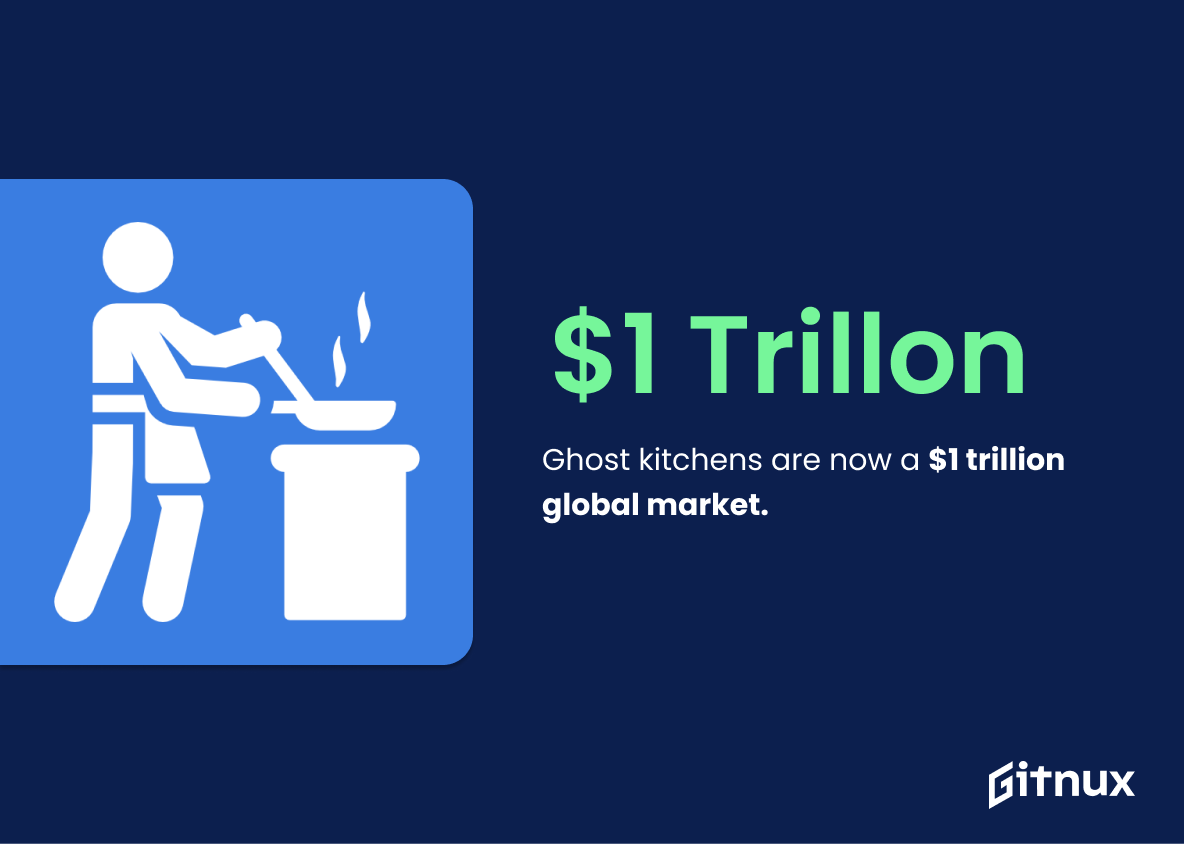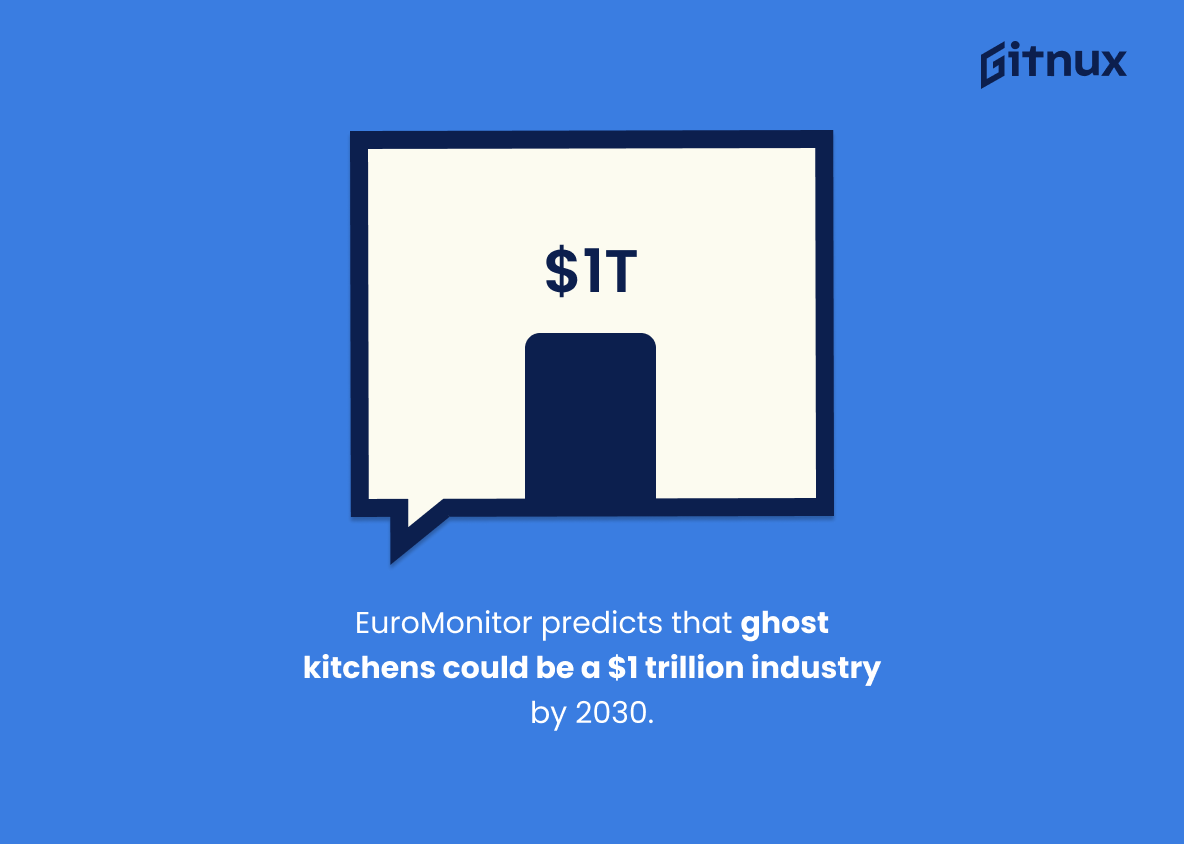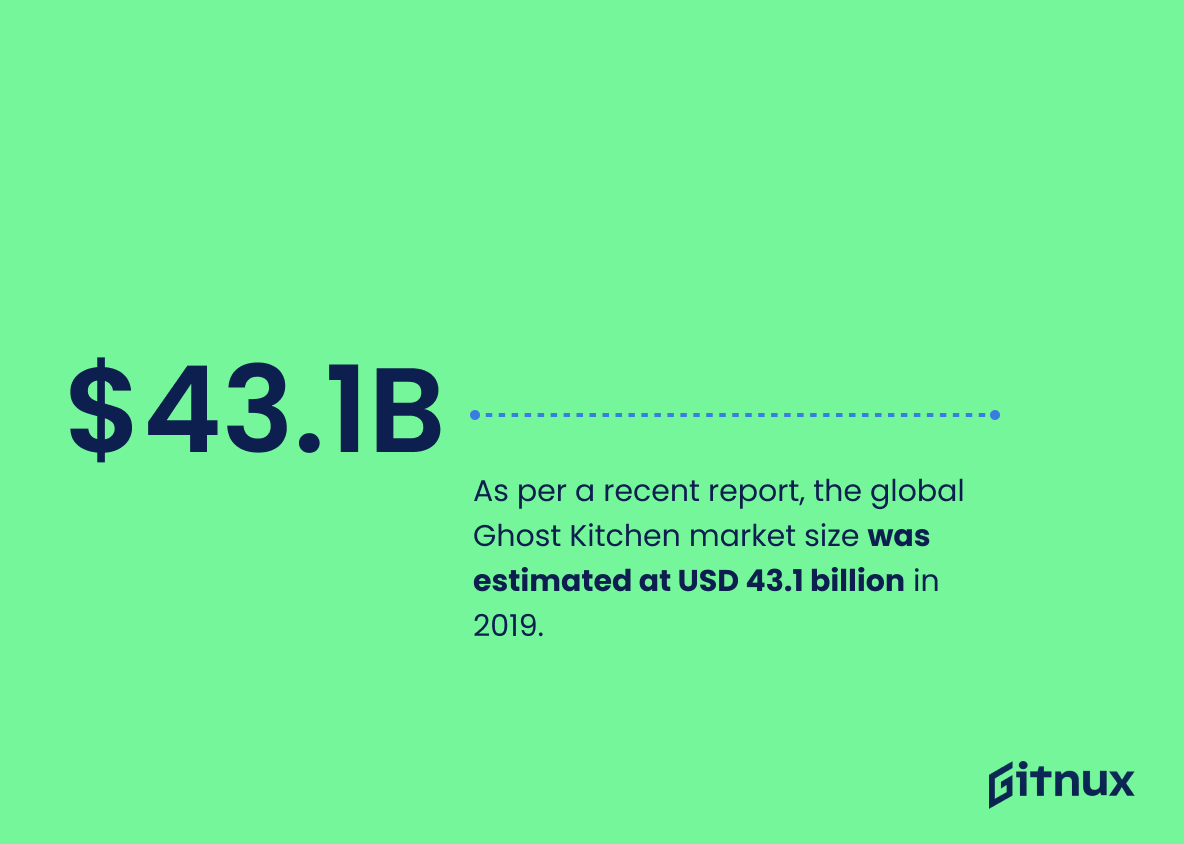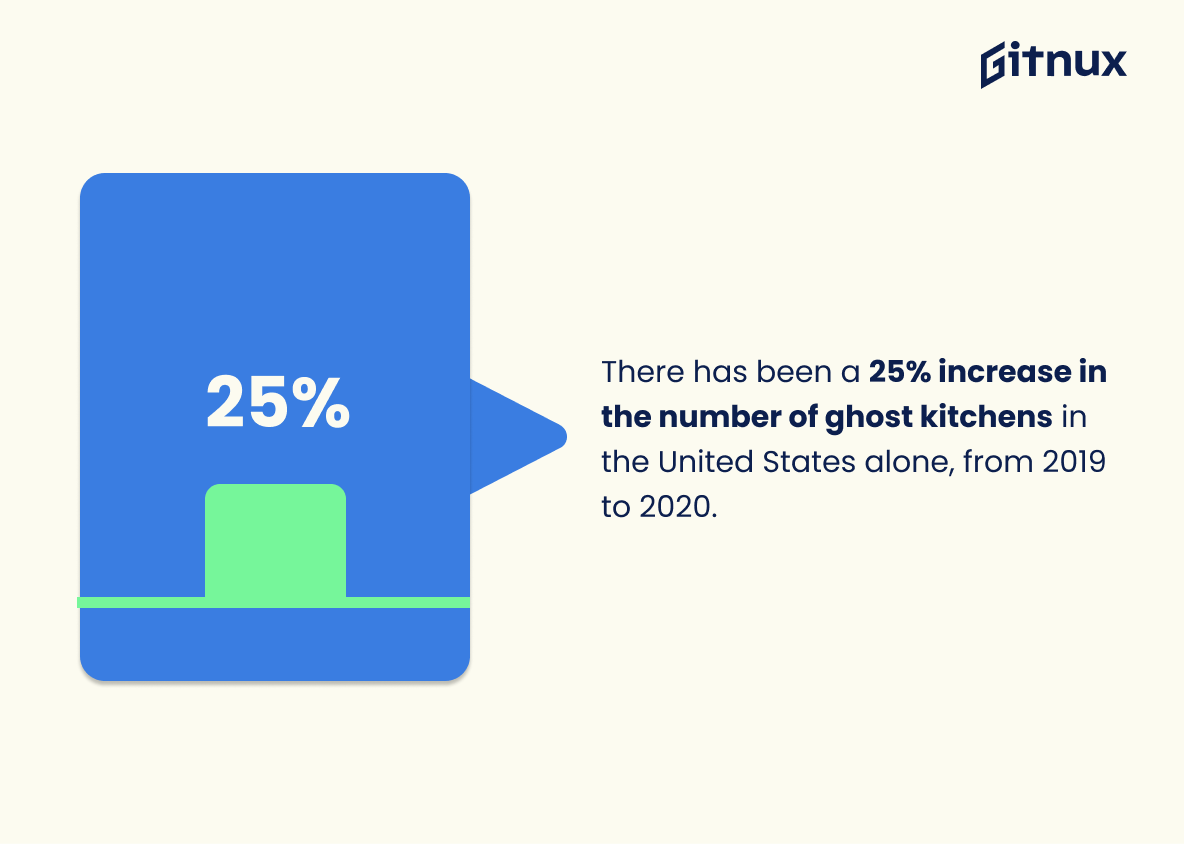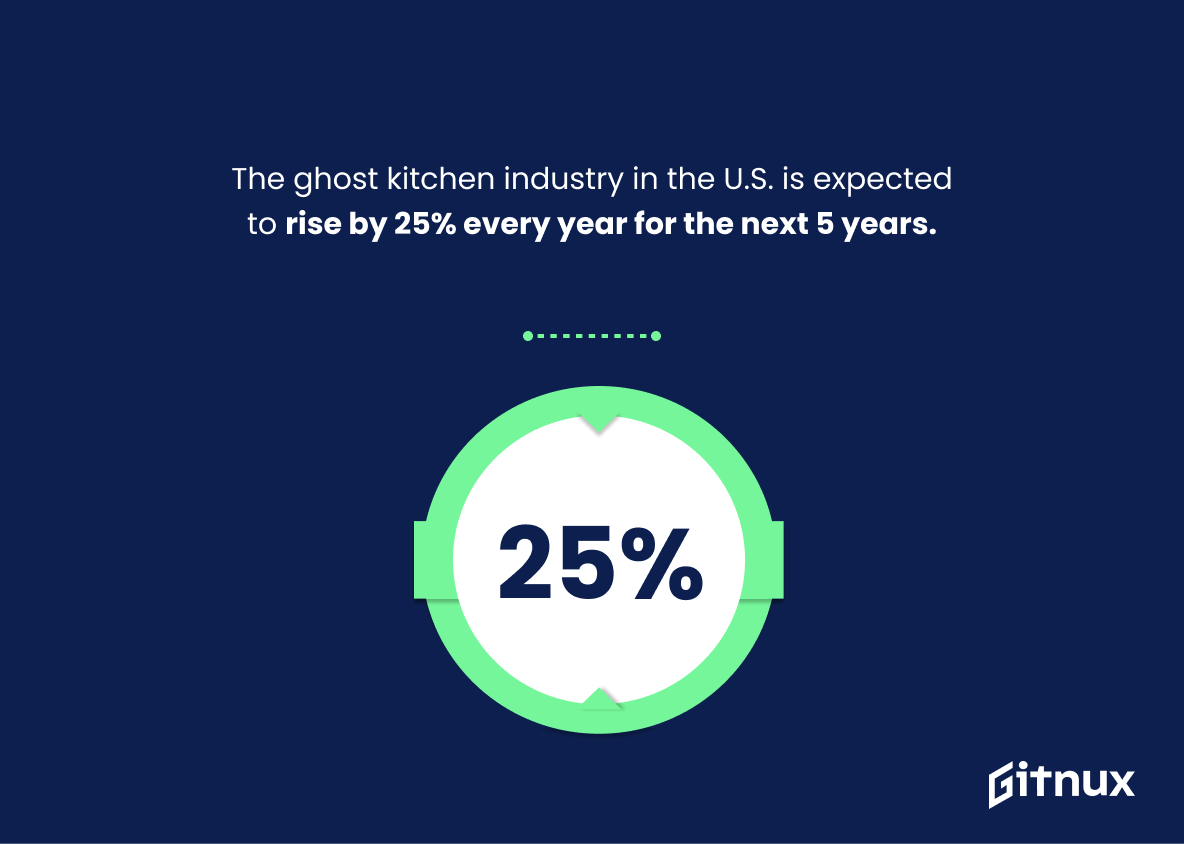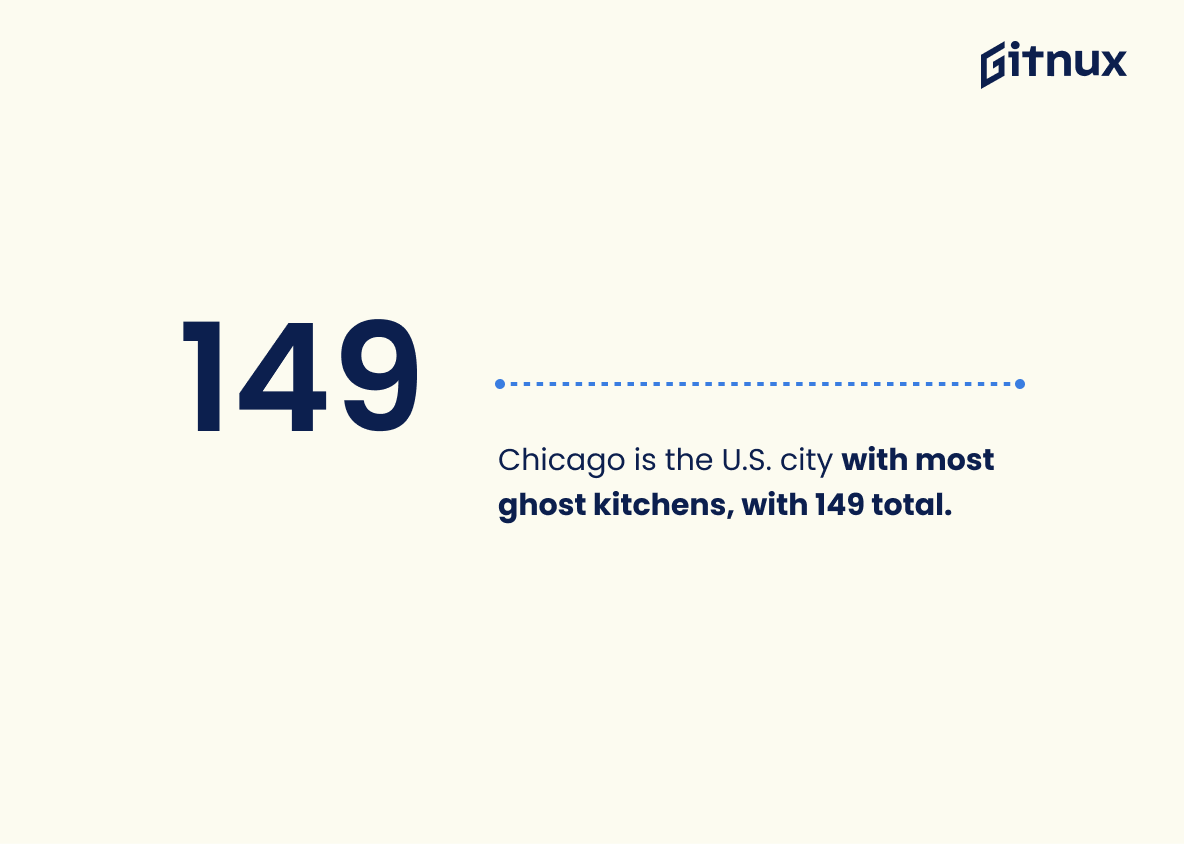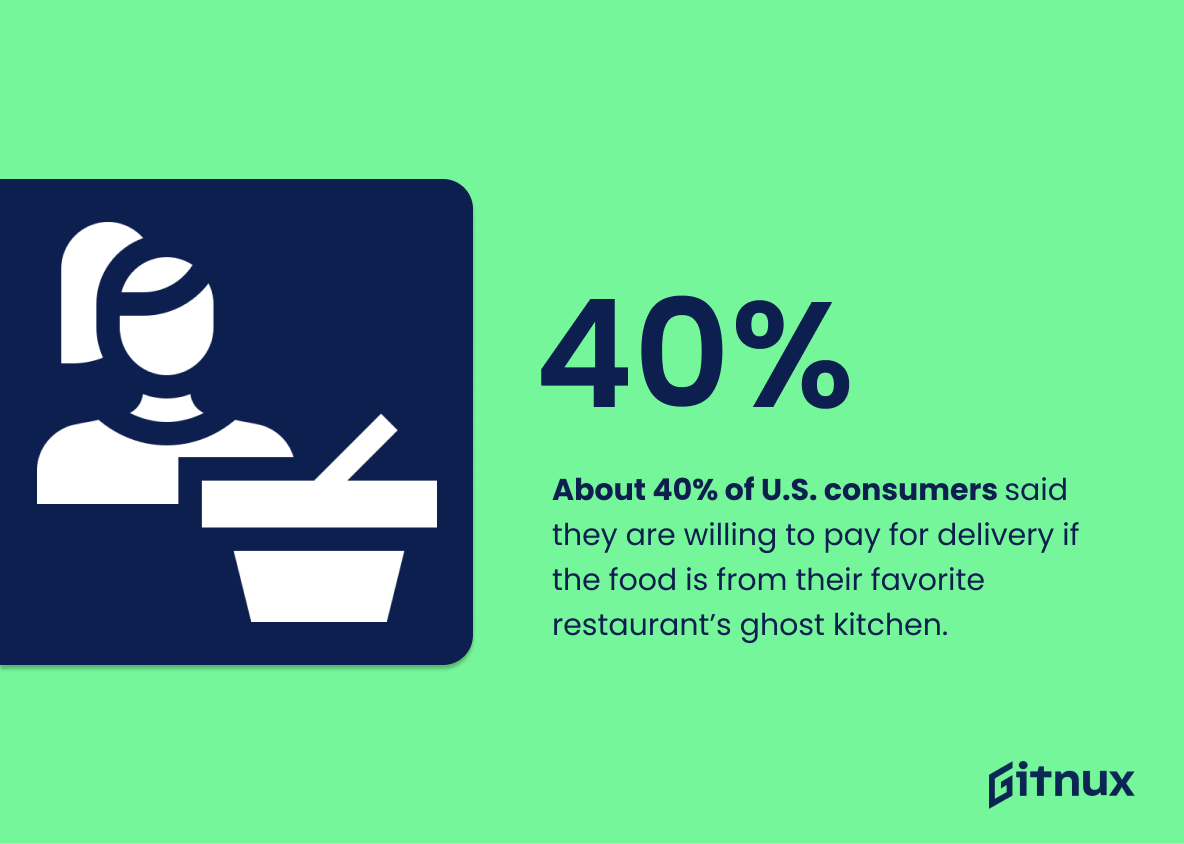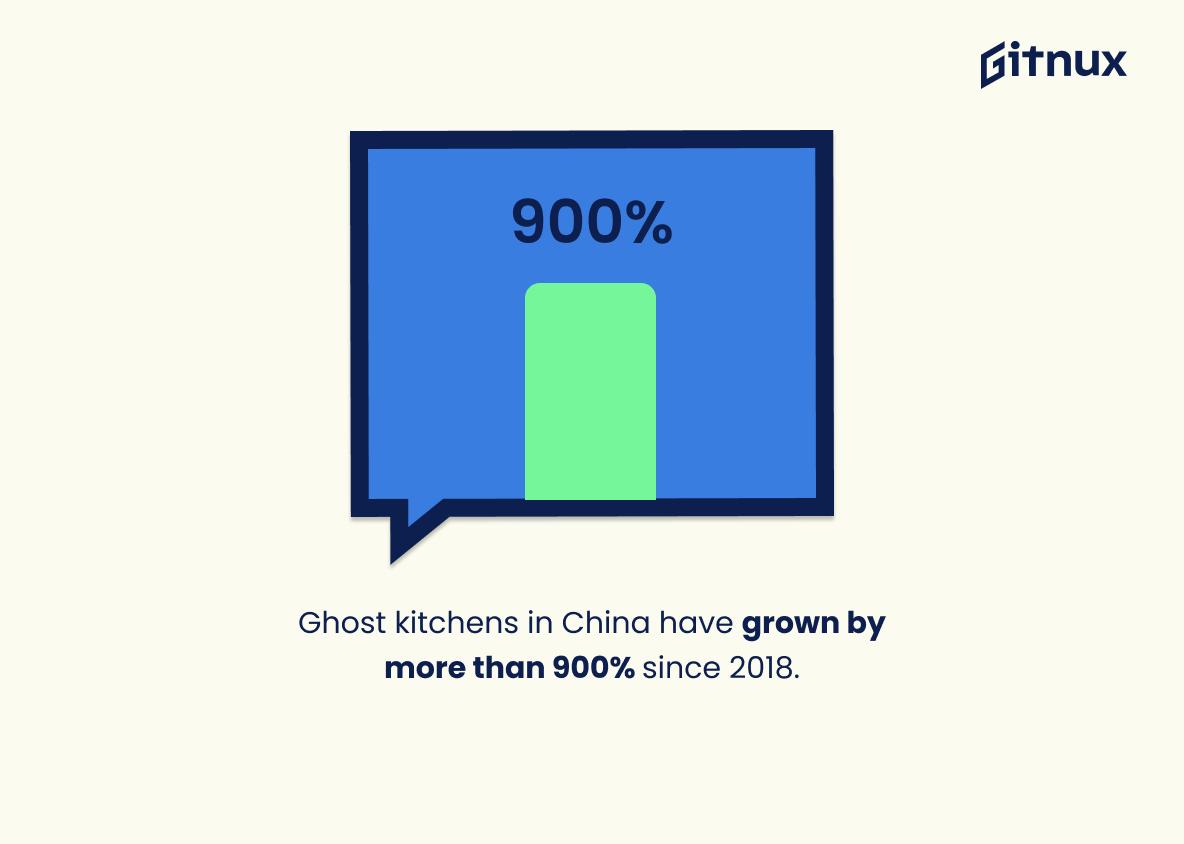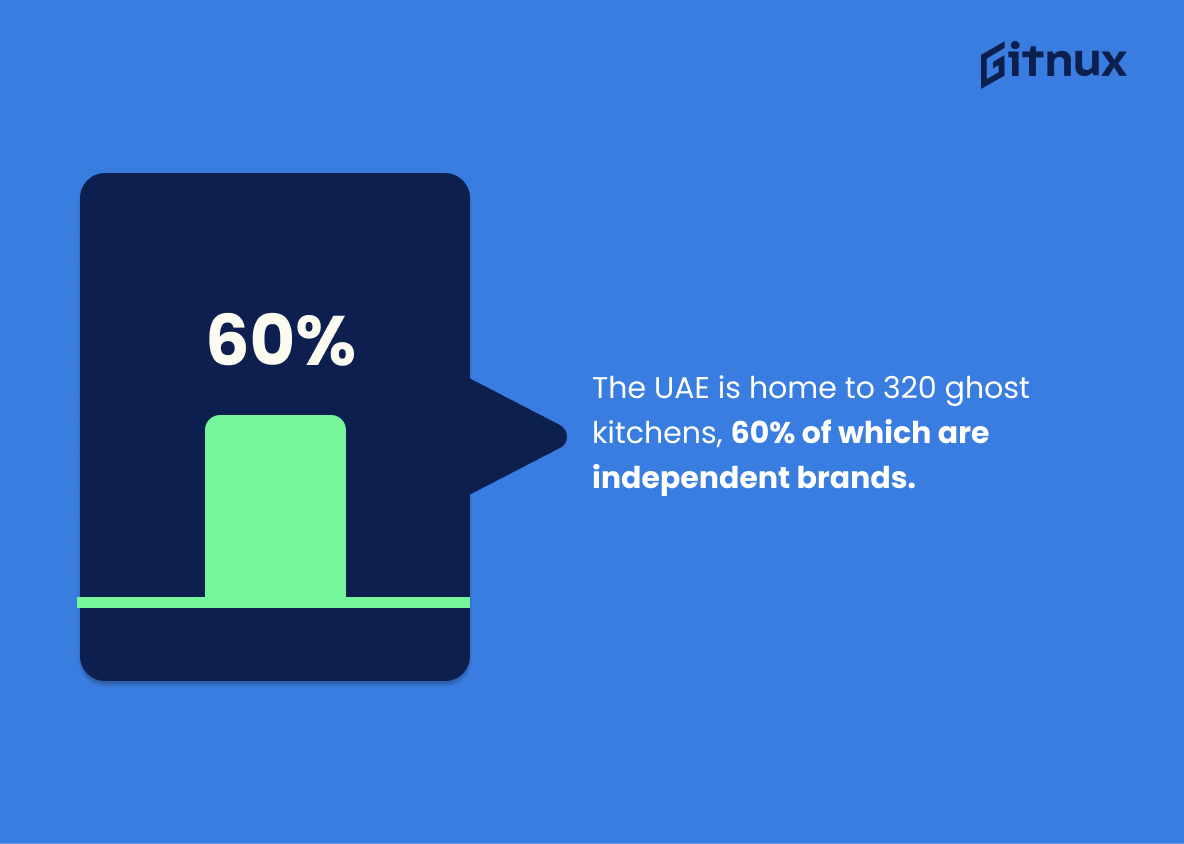Welcome to an insightful exploration into the fascinating world of Ghost Kitchens. This blog post is designed to serve up a veritable buffet of cutting-edge industry statistics that will satiate your curiosity, ignite your interest, and provide tangible insights into the rapidly evolving landscape of this innovative sector. As the demand for food delivery soars, the Ghost Kitchen concept redefines traditional dining, merging convenience with culinary delight. Whether you’re an intrigued food enthusiast, a budding entrepreneur, or an avid industry player seeking to stay abreast with the latest trends, this post extensively covers the data and dynamic statistics defining the progress and potential of the Ghost Kitchen industry globally. Let’s delve in to taste the flavors of this transformative food industry trend.
The Latest Ghost Kitchen Industry Statistics Unveiled
Ghost kitchens are now a $1 trillion global market.
Unraveling the magnitude of the global market for ghost kitchens, this dazzling figure of a $1 trillion valuation, is nothing short of revolutionary on the gastronomic stage. In an era where dining trends are rapidly shifting, this statistic underlines a seachange in how we eat – consumers are reaching out for convenient, delivery-ready meals more than ever. The hefty price tag attached to the market indicates its burgeoning growth and untapped potential. For the discerning entrepreneur, it’s a clarion call, a grand invitation to step into this booming sector. Furthermore, this numbers-game situates ghost kitchens as a dominant force in the food industry, compelling stakeholders to pivot, adapt, re-strategize, or risk being left behind. So, in a nutshell, this statistic carves out the significance of the ghost kitchen industry, illuminating its pivotal role in shaping the future of food and business.
EuroMonitor predicts that ghost kitchens could be a $1 trillion industry by 2030.
The extraordinary projection of EuroMonitor, estimating ghost kitchens to reach a formidable market size of $1 trillion by 2030, provides a gustatory feast of thought for investors, stakeholders, and enthusiasts in the Ghost Kitchen industry. This dazzling figure serves as a crystal ball glimpse into the future, revealing the immense potential and lucrative opportunities that lie ahead. The increasingly digital-driven world, paired with the growing demand for convenience, creates the perfect recipe for this industry’s unprecedented growth. Cooking up such gargantuan prediction is a clear testament to the transformation happening right under our noses – in our kitchens. Whether you’re a restaurateur, an investor, or merely someone with an insatiable curiosity, this exciting forecast is your power ingredient to understanding the seemingly unstoppable momentum of the Ghost Kitchen revolution. This, indeed, is not something to be shoved in the corner of your storage room but rather placed center stage on your kitchen counter.
As per a recent report, the global Ghost Kitchen market size was estimated at USD 43.1 billion in 2019.
Highlighting the immense value of the global Ghost Kitchen market at USD 43.1 billion in 2019 sets the stage for understanding the massive economic potential within this burgeoning industry. Not merely a fad or niche, this figure underlines the Ghost Kitchen’s standing as a significant player in the foodservice sector. The report offers an undeniable perspective on this industry’s enormity, further prompting industry insiders, investors, and aspirants to consider its profound implications. Through the hard lens of dollars and cents, we accurately gauge the present economic scale of the Ghost Kitchen industry, navigate its future path, and anticipate the opportunities it holds.
There has been a 25% increase in the number of ghost kitchens in the United States alone, from 2019 to 2020.
In the sparkling narrative of Ghost Kitchen Industry Statistics, the pulsating surge of a 25% increase in ghost kitchens in the United States from 2019 to 2020 creates an enticing subplot. This startling jump paints an intriguing picture of the landscape, igniting the torch that illuminates the path of this industry’s growth. The quartet increase excites the curiosity, like a sizzling secret, revealing not just the industry’s growing popularity, but also offering a sneak peek into the changing face of the food industry. This statistic offers a glimpse into the future, amplifying the importance of understanding and dissecting these evolving trends. Isn’t it stirring? An industry silently revolutionizing behind closed doors, turning the tables, one ‘ghost’ eatery at a time.
The ghost kitchen industry in the U.S. is expected to rise by 25% every year for the next 5 years.
In the panorama of Ghost Kitchen Industry Statistics, a forecast such as a 25% annual surge for the next five years stands as a lighthouse for investors and entrepreneurs. Mapped out in this vibrant prediction, a landscape of ample opportunity unveils itself, promising exponential growth within the stratums of the Ghost Kitchen industry. The manifestation of such acceleration could herald a seismic shift, redrawing the boundaries of the food delivery sector, potentially reshaping the way America eats. Harnessing this power for strategic positioning, entrepreneurs and investors alike can ride high on this tsunami of growth, elevating their ventures to new heights. This is the power and potential contained within these projected growth figures.
In 2020, the pick-up/delivery revenue for ghost kitchen’s averaged $487,000.
Highlighting the average pick-up/delivery revenue for ghost kitchens in 2020 serves as a key beacon in illustrating the financial gravity of this emerging sector. It projects the potential earning power of these kitchens and provides an insightful benchmark for potential investors, owners and other stakeholders. This robust figure, standing at $487,000, showcases the undeniable vibrancy and viability of the ghost kitchen industry, further enticing the interest and confidence of entrepreneurs and businesses towards a relatively new yet booming market. The rise of this digital-first restaurant model, therefore, is not just a passing trend, but a lucrative venture strategically rooted in consumer behavior and progressively reshaping the restaurant landscape.
Sixty-seven percent of consumers said they are more likely to purchase takeout than before the pandemic.
Reflecting on the stated statistic, it sheds light on a significant change in consumer behavior primarily driven by the pandemic – an increased preference for takeout meals. In the grand scheme of Ghost Kitchen Industry Statistics, this is quite the revelation. Ghost kitchens, by definition, are delivery-only or takeout restaurants without a traditional dine-in space.
The noted 67% surge in consumers leaning towards takeout isn’t just a mere observation but a key driver for the escalating momentum of the Ghost Kitchen industry. It illustrates the burgeoning opportunity for operators in this sector. With more consumers developing a preference for ordering food rather than dining out, the businesses operating within these ghost kitchens stand to seize this behavioral shift and meet heightened demand, consequently flourishing within this industry.
Essentially, this statistic serves as a promising data point hinting at the tangible growth potential for businesses within the Ghost Kitchen industry. It underscores a significant market trend with potentially far-reaching implications for industry projections and strategic foresight within the ever-evolving landscape of the food and hospitality sector.
Chicago is the U.S. city with most ghost kitchens, with 149 total.
Unmasking the spectral presence of ghost kitchens in the U.S., it’s astounding to witness Chicago snagging the title as the spectral capital, boasting a sum of 149 ghost kitchens in the city’s spectral gastronomy industry. This noteworthy figure shines an ethereal light on the magnitude of this modern dining trend taking root in our culture. Implying a burgeoning business model, this prevalence illuminates the potential profitability and growth opportunities for entrepreneurs aspiring to venture into this niche, especially in the Windy City. This figure also underscores Chicago as a potential hotspot for culinary innovation, since ghost kitchens often function as testing grounds for new food concepts.
NYC and LA have more than 100 ghost kitchens each.
Highlighting the fact that New York City and Los Angeles each host more than 100 ghost kitchens not only underscores the growing dominance of this new business model in the foodservice industry but also serves as a testament to its increasing popularity and acceptance in major urban hubs. These cities, vibrant and bustling culinary landscapes in their own right, illustrate the successful inroads this paradigm-shifting concept has made, with many traditional restaurants embracing these invisible kitchens. Additionally, this statistic provides an illustrative context, serving as a compelling backdrop to a discussion on the thriving ghost kitchen industry, illustrating the scale at which this industry operates in high-density areas.
Delivery sales made by restaurants and grocery stores are expected to jump by more than 60% by 2022.
An intriguing contemplation about the stat foreseeing an over 60% rise in delivery sales by restaurants and grocery stores by 2022 can be perceived as a cryptic compass directing the course of the Ghost Kitchen Industry. The plotted trajectory of this surge places the ghost kitchens at the epicenter of this impending disruption. Simply put, these establishments, which have adeptly positioned themselves to cater to this rise, stand at the cusp of an explosive growth phase. Their strategic alignment to the trends predict immense, unprecedented opportunities within this sector, potentially catapulting them towards lucrative horizons.
About 40% of U.S. consumers said they are willing to pay for delivery if the food is from their favorite restaurant’s ghost kitchen.
Highlighting the data that reveals ‘around 40% of U.S. consumers are ready to pay for delivery if the food hails from their preferred restaurant’s ghost kitchen’, paints an intriguing picture of the burgeoning ghost kitchen landscape. This insight offers an invaluable perspective on consumer behavior and their willingness to pay extra for convenience, particularly from a favored culinary source. In a blog post delving into Ghost Kitchen Industry Statistics, this piece of knowledge spotlight not only the potential profitability of the industry but also underlines a consumer trend that stakeholders can leverage for devising strategic and profitable business models. Above all, this statistic can serve as a beacon for guiding investment decisions, operational approaches, and marketing strategies within this rapidly evolving segment of the food service industry.
Ghost kitchens in China have grown by more than 900% since 2018.
Taking center stage in our data symphony, consider the crescendo brought by the statistic showing a staggering 900% growth of ghost kitchens in China since 2018. This specter of a trend serves as a powerful force behind the ghost kitchen industry’s narrative. Not just a mere digit to decorate our blog, it serves to underline China’s prominent role as an eager adopter and nurturer of this innovative foodservice model. It sets the stage for further discussion on how cultural, economic, and technological transformations in one of the world’s largest markets can echo across the globe and define future industry trajectories. This nine-fold surge becomes the exclamation mark at the end of the sentence, emphasizing the momentum and potential that the ghost kitchen industry possesses.
As of 2020, Europe had more than 750 ghost kitchens.
Highlighting the formidable presence of over 750 ghost kitchens in Europe as of 2020 in a blog post about Ghost Kitchen Industry Statistics provides a compelling snapshot of the emergent prominence and continental acceptance of this disruptive business model. It fosters a comprehensive understanding of the industry’s geographic expansion and trend receptivity in Europe, thereby offering ample market insights to readers, industry enthusiasts, investors, and aspiring entrepreneurs. Strategically, it also channels discussions around potential market competition, growth strategy, consumer behavior, and regulatory impacts in the regional ghost kitchen industry.
The UAE is home to 320 ghost kitchens, 60% of which are independent brands.
In an age where the virtual landscape shapes key industries, the fact that the UAE houses 320 ghost kitchens emerges as a compelling reflection of this transformative trend. Notably, these ghost kitchens are not just prolific, but they exhibit a remarkable streak of entrepreneurship – with 60% of them being independent brands. This metric illustrates a booming digital pivot in the F&B sector, imbuing the ghost kitchen industry with a vibrant potential for unique culinary entrepreneurs. The information forms a thought-provoking backdrop displaying unexpected opportunities for startups, suggestive of rewarding financial potential awaiting exploration in this vivid online dining scene. Indeed, a fact with such immediacy adds a punch of relevance and authority to a blog post centered on ghost kitchen industry statistics. It unravels the evolving fabric of this sector, making the subject matter more engaging for readers.
In 2019, SoftBank announced an investment of $375 million into a ghost kitchen start-up, with further plans to invest another $375 million.
Highlighting the mentioned statistic brings to the forefront the dramatic financial injection into the ghost kitchen industry, signifying the sector’s potential profitability and growth. With heavyweights like SoftBank placing a whooping $375 million backing into a ghost kitchen start-up, it doesn’t just illuminate the sector’s lucrative possibilities, but also amplifies the credibility of the business model. This planned repetition of such a monumental investment indicates an optimistic vision for the industry’s future, hinting a possibly rising trend in the food and hospitality sector. The effects of this could echo through the industry as it might inspire burgeoning entrepreneurs and stir interest among other big investors. In the bigger scheme, the statistic signifies an increased acceptance and reliance on technology-driven solutions in traditional sectors – a telling tale of changing times.
Conclusion
In a nutshell, the ghost kitchen industry has revolutionized the food service sector significantly, offering remarkable prospects for both restaurateurs and consumers. The statistics we’ve explored highlight the booming growth and future of this thriving industry. As takeout and delivery services continue to soar, ghost kitchens are extremely well-positioned to capitalize on these trends. While challenges do exist, businesses that can adapt to virtual models stand poised to reap significant benefits in the coming years. With the industry still in its relative infancy, the future is ripe for inventive entrepreneurs who can leverage the efficiency and cost-effectiveness of ghost kitchens.
References
0. – https://www.www.chicagotribune.com
1. – https://www.www.qsrmagazine.com
2. – https://www.www.businessinsider.com
3. – https://www.www.menabytes.com
4. – https://www.www.restaurantbusinessonline.com
5. – https://www.www.bdo.com
6. – https://www.www.forbes.com
7. – https://www.www.restaurantdive.com
8. – https://www.blog.taboola.com
9. – https://www.www.eu-startups.com
10. – https://www.www.webstaurantstore.com
11. – https://www.www.kr-asia.com
12. – https://www.www.prnewswire.com
13. – https://www.secondmeasure.com
